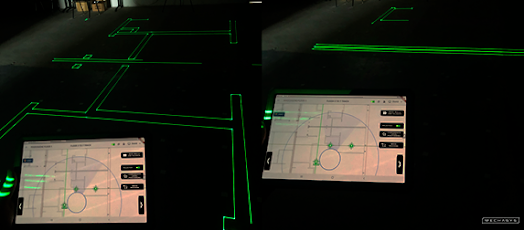If you’ve ever worked with laser technology, have you ever wondered how laser projection actually works? Why is it similar to TV? And why is the laser green? Well, let’s unravel this stunning technology to uncover its secrets.
Laser Projection Technology
To begin with, a laser emits a beam of light in a focused spot. In fact, did you know that laser is actually the acronym for “Light Amplification by Stimulated Emission of Radiation”? Laser light is emitted and it is then reflected by a device called the mirror galvanometer. A pair of galvo mirrors (short for galvanometer) are constantly vibrating at a super-fast pace. By continually oscillating like this, the laser light will bounce off the first galvo mirror, which controls the movement on the X-axis, and the second galvo mirror, determining movement on the Y-axis. By controlling these oscillating mirrors, you can project shapes, like lines, as predetermined in the 2D environment (e.g. concrete surface). This process will use a device that will amplify the laser emission, allowing us to see the laser projection on a larger scale.
What does laser projection and TV have in common?
Laser projection is, as mentioned, a dot projected on a surface. This laser dot moves at a fast pace along the determined coordinates in an optimal order, therefore creating laser lines. When we perceive a stable image on the surface, it means the dot is moving along the projected trajectory at a pace of more than 24 frames per second. This represents the number of times the laser dot projection has been captured per second along the coordinates, on the surface. Frames per second (fps) is the speed rate at which frames (still images) are captured and projected per second. For reference, 24 frames per second (fps) is the standard for movies and TV shows and images are shown in the same way (fast dots moving on the screen to recreate the image). As you can see on the moving image below, a lower pace of frames per second show a more jerky movement of the image versus a faster pace projecting a more smooth and fluid transition of the image’s movement in the video

If you’re interested in learning more about frames per second, here is a comprehensive guide.
Why is the laser beam green?
Overall, laser technologies use a green laser over red. Why a green laser? It comes down to how we humans perceive colours. As you know, colours come from light. Colours are specific wavelengths in light that we process and perceive as what we call colour. The range of green colours (from turquoise to a yellow-orange) is the one we are most sensitive to, hence why it seems the brightest for us. For the light of laser beam, green can actually be up to 4-5 times more visible to a person’s eye (considering the red and green laser are at the same output power).
Although laser technologies date back to the 1900s, we’ve just begun tapping its potential for commercial construction use. Since then, a variety of tools has begun to appear and the potential for construction work has yet to be exploited. What’s one advantage or pro of laser projection you can think of for construction applications on sites? If you’ve used or owned laser technology, let us know your experience with it!


